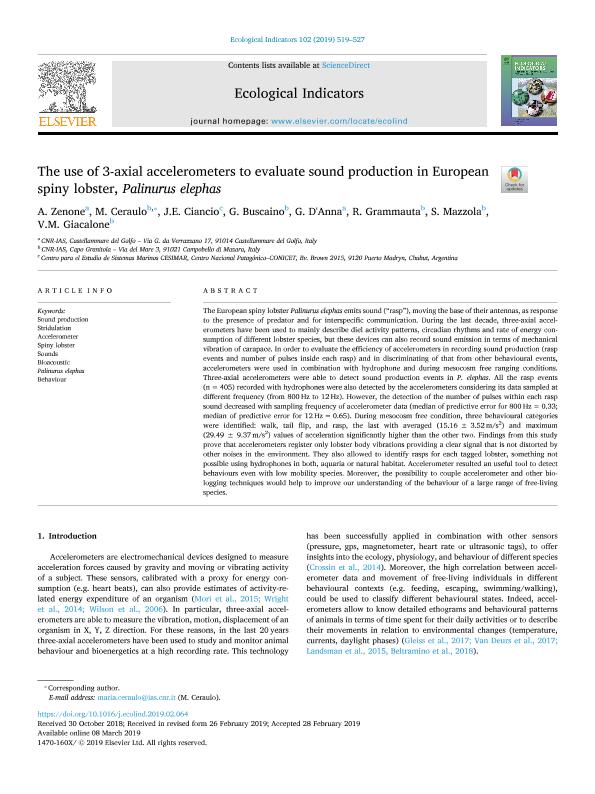Mostrar el registro sencillo del ítem
dc.contributor.author
Zenone, Arturo
dc.contributor.author
Ceraulo, Maria

dc.contributor.author
Ciancio Blanc, Javier Ernesto

dc.contributor.author
Buscaino, Giuseppa

dc.contributor.author
D'Anna, Giovanni
dc.contributor.author
Grammauta, Rosario
dc.contributor.author
Mazzola, Salvatore

dc.contributor.author
Giacalone, Vincenzo Maximiliano
dc.date.available
2020-10-29T18:16:21Z
dc.date.issued
2019-07
dc.identifier.citation
Zenone, Arturo; Ceraulo, Maria; Ciancio Blanc, Javier Ernesto; Buscaino, Giuseppa; D'Anna, Giovanni; et al.; The use of 3-axial accelerometers to evaluate sound production in European spiny lobster, Palinurus elephas; Elsevier Science; Ecological Indicators; 102; 7-2019; 519-527
dc.identifier.issn
1470-160X
dc.identifier.uri
http://hdl.handle.net/11336/117175
dc.description.abstract
The European spiny lobster Palinurus elephas emits sound (“rasp”), moving the base of their antennas, as response to the presence of predator and for interspecific communication. During the last decade, three-axial accelerometers have been used to mainly describe diel activity patterns, circadian rhythms and rate of energy consumption of different lobster species, but these devices can also record sound emission in terms of mechanical vibration of carapace. In order to evaluate the efficiency of accelerometers in recording sound production (rasp events and number of pulses inside each rasp) and in discriminating of that from other behavioural events, accelerometers were used in combination with hydrophone and during mesocosm free ranging conditions. Three-axial accelerometers were able to detect sound production events in P. elephas. All the rasp events (n = 405) recorded with hydrophones were also detected by the accelerometers considering its data sampled at different frequency (from 800 Hz to 12 Hz). However, the detection of the number of pulses within each rasp sound decreased with sampling frequency of accelerometer data (median of predictive error for 800 Hz = 0.33; median of predictive error for 12 Hz = 0.65). During mesocosm free condition, three behavioural categories were identified: walk, tail flip, and rasp, the last with averaged (15.16 ± 3.52 m/s2 ) and maximum (29.49 ± 9.37 m/s2 ) values of acceleration significantly higher than the other two. Findings from this study prove that accelerometers register only lobster body vibrations providing a clear signal that is not distorted by other noises in the environment. They also allowed to identify rasps for each tagged lobster, something not possible using hydrophones in both, aquaria or natural habitat. Accelerometer resulted an useful tool to detect behaviours even with low mobility species. Moreover, the possibility to couple accelerometer and other biologging techniques would help to improve our understanding of the behaviour of a large range of free-living species.
dc.format
application/pdf
dc.language.iso
eng
dc.publisher
Elsevier Science

dc.rights
info:eu-repo/semantics/openAccess
dc.rights.uri
https://creativecommons.org/licenses/by-nc-nd/2.5/ar/
dc.subject
ACCELEROMETER
dc.subject
BEHAVIOUR
dc.subject
BIOACOUSTIC
dc.subject
PALINURUS ELEPHAS
dc.subject
SOUND PRODUCTION
dc.subject
SOUNDS
dc.subject
SPINY LOBSTER
dc.subject
STRIDULATION
dc.subject.classification
Biología Celular, Microbiología

dc.subject.classification
Ciencias Biológicas

dc.subject.classification
CIENCIAS NATURALES Y EXACTAS

dc.title
The use of 3-axial accelerometers to evaluate sound production in European spiny lobster, Palinurus elephas
dc.type
info:eu-repo/semantics/article
dc.type
info:ar-repo/semantics/artículo
dc.type
info:eu-repo/semantics/publishedVersion
dc.date.updated
2020-08-04T19:39:12Z
dc.journal.volume
102
dc.journal.pagination
519-527
dc.journal.pais
Países Bajos

dc.journal.ciudad
Amsterdam
dc.description.fil
Fil: Zenone, Arturo. Istituto per l'ambiente Marino Costiero; Italia. Consiglio Nazionale delle Ricerche; Italia
dc.description.fil
Fil: Ceraulo, Maria. Istituto per l'ambiente Marino Costiero; Italia. Consiglio Nazionale delle Ricerche; Italia
dc.description.fil
Fil: Ciancio Blanc, Javier Ernesto. Consejo Nacional de Investigaciones Científicas y Técnicas. Centro Científico Tecnológico Conicet - Centro Nacional Patagónico. Centro para el Estudio de Sistemas Marinos; Argentina
dc.description.fil
Fil: Buscaino, Giuseppa. Istituto per l'ambiente Marino Costiero; Italia. Consiglio Nazionale delle Ricerche; Italia
dc.description.fil
Fil: D'Anna, Giovanni. Consiglio Nazionale delle Ricerche; Italia. Istituto per l'ambiente Marino Costiero; Italia
dc.description.fil
Fil: Grammauta, Rosario. Consiglio Nazionale delle Ricerche; Italia. Istituto per l'ambiente Marino Costiero; Italia
dc.description.fil
Fil: Mazzola, Salvatore. Consiglio Nazionale delle Ricerche; Italia. Istituto per l'ambiente Marino Costiero; Italia
dc.description.fil
Fil: Giacalone, Vincenzo Maximiliano. Consiglio Nazionale delle Ricerche; Italia. Istituto per l'ambiente Marino Costiero; Italia
dc.journal.title
Ecological Indicators

dc.relation.alternativeid
info:eu-repo/semantics/altIdentifier/doi/http://dx.doi.org/10.1016/j.ecolind.2019.02.064
dc.relation.alternativeid
info:eu-repo/semantics/altIdentifier/url/https://www.sciencedirect.com/science/article/abs/pii/S1470160X19301712?via%3Dihub
Archivos asociados
